
22
About Your Scanner
Type I systems are usually organized with different user
groups assigned to different fleets. For example, a valid
fleet-subfleet ID identifying all detectives within a police
department might be
òòòVñð
òòòVñð
òòòVñð
òòòVñð
, where 000 identifies all po-
lice users and 12 identifies the Detective division.
To properly map the raw Type I data to the correct fleet-
subfleet format, you must program the correct fleet map
into the scanner. Fleet map information is widely avail-
able on the Internet for most Type I systems in use.
Type II system talk groups are identified by a 5-digit
number. Valid talk group IDs are divisible by 16. If you
try to enter an invalid talk group ID, the scanner rounds
the ID down to the next valid ID.
Type I/II hybrid systems use both fleet-subfleet and 5-
digit formats for talk group IDs.
Note: If the scanner decodes control channel data while
receiving transmissions from a Motorola trunking sys-
tem,
á*0.(
á*0.(
á*0.(
á*0.(
appears on the bottom line of the display.
EDACS Mode
You can set your scanner so it decodes the talk group
IDs used with EDACS (GE/Ericsson) trunking systems.
This setting is called the EDACS mode.
EDACS systems are trunking systems used primarily by
business or private communications service providers,
as well as by some public safety organizations. EDACS
systems transmit active talk group information only on a
dedicated control channel.
EDACS frequencies are organized in a specific order.
Each frequency is assigned a Logical Channel Number
(LCN). For the scanner to correctly switch to an active
frequency, you must program the frequencies in LCN or-
der, starting with
)<DFIPýòñ
)<DFIPýòñ
)<DFIPýòñ
)<DFIPýòñ
. EDACS talk group IDs are
entered as a 4-digit decimal number from 0001 to 2047
or AFS (Agency Fleet Subfleet) number from 00-001 to
15-157.
When there is activity on an EDACS system, that infor-
mation is sent out on the control channel. The scanner
decodes the ID for the active talk group. In the open















































